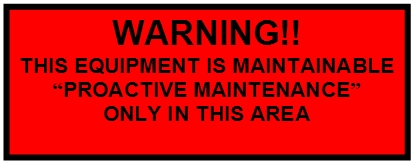Improving Plant OEE and reducing downtime is biggest concern most of the organisation have. Here are steps on how to Reduce downtimes and Improve your Plant OEE
Number 1: Learn about Kaizen & TPM (Total Productive Maintenance) & other world class maintenance techniques. RIB Consulting experts can help you learn TPM through TPM workshops and TPM Certification courses in India, Kenya and Dubai.
Number 2: Do Ranking of your Assests. Risk can mean many things to many people. Develop a small list of questions to develop your ranking of assets. Equipment Ranking is normally based on following criteria – Production (Average Level of operation, MTBF, Downtime hours etc), Quality, Cost, Safety
Number 3: Begin writing work orders for all emergency and preventive maintenance work on RANK A and B assets based on your ranking of assets above. Ensure accurate labor hours are added to each. Track and trend these hours against each other and post the results after 4 weeks. Ask a team of operators and maintenance personnel to make recommended changes to the TPM program on worst performing assets as a result.
Number 4: Restore, one step at a time, your highest risk asset in worst condition and at the same time develop operator and maintenance preventive maintenance procedures. These procedures should include steps (yes, step by step), specifications, parts (filters with storeroom number), permits required, estimated time required to complete, etc.
Number 5: Once the asset is restored and a repair has been made then a corrective maintenance procedure must be written with specifications, steps, estimated labor hours, drawings, special tools, etc. identified.
Number 6: Use the new TPM procedures on the newly restored asset. Apply the 10% Rule of Preventive Maintenance. This rule is defined as a PM that must be completed within 10% of the time standard. Example: if the PM requires to be accomplished every 30 days then it must be completed within 3 days or it is out of compliance. The expected goal is 100% compliance. It may not start out this way but should end up this way.
Number 7: Fabricate a sign that states “Warning, This Equipment is Maintainable, Only Proactive Maintenance in this Area “, See the example below. Only allow your best maintenance personnel and operators to work in this area.

Number 8: Develop Overall Equipment Effectiveness (OEE) metrics for the production area. If you don’t know how to make this happen just send us an email (contact@ribcon.com) and we will help. Post the daily and shift OEE on a line graph and show the trend. Leadership needs to back off and let the operators and maintenance personnel do their job and lead this effort.
OEE = Equipment Availability x Performance Efficiency x First Pass Quality with World-class levels of OEE start at 85% based on the following values: 90% Equipment Availability x 95% Performance Efficiency x 99% Rate of Quality = OEE of 84.6%
The OEE calculation factors in the major losses it seeks to eliminate. The first focus should be on major equipment effectiveness losses, because this is where the largest gains can be realized in the shortest time.
There are 11 major areas of loss, and they fall within four broad categories:
Equipment Availability:
Planned-shutdown losses
1. No production, breaks, and/or shift changes
2. Planned maintenance Downtime Losses
3. Equipment failure or breakdowns
Setups and changeovers
4. Tooling or part changes
5. Start-up and adjustment
Performance Efficiency:
Performance efficiency losses
6. Minor stops (less than six minutes)
7. Reduced speed or cycle time
First Pass Quality (Yes, First Pass Quality ONLY)
Quality Losses
9. Scrap product/output
10. Defects or rework
11. Yield or process transition losses
Number 9: Develop a vendor performance metric. This metric will have three parts. One, the percentage of time a vendor delivers a part on “the agreed upon time” (one minute late is late, sorry); two, the percentage of time the same vendor delivers the wrong part (no substitution unless agreed upon by maintenance manager); three, the times the same vendor delivers the wrong quantity of parts. The sum of these three measurements equals the vendor performance metric. Post this metric by vendor by month in the storeroom. The standard should be 95%, sorry no excuses accepted.
Number 10: Now take the assessment on maintenance process beginning with the planning and scheduling process first.


